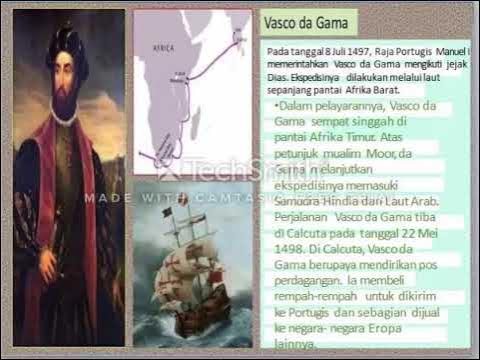KETIKA BUMI HANYA MILIK PORTUGIS DAN SPANYOL || PERJANJIAN TORDESILLAS DAN SARAGOSA
Summary
TLDRThe video script delves into the historical significance of the Treaty of Tordesillas, outlining how Spain and Portugal divided the New World in the late 15th century. It discusses the treaty's background, Pope Alexander VI's role, and the subsequent explorations leading to the discovery of new territories. The script further explores the Treaty of Zaragoza, which adjusted the earlier division, and its implications on colonial control, particularly in the spice-rich Maluku Islands. The narrative concludes with the eventual decline of Spanish and Portuguese dominance and the rise of other European powers, setting the stage for modern imperialism.
Takeaways
- 🌍 The Tordesillas Treaty was an agreement between Portugal and Spain in the 15th century to divide the newly discovered lands outside Europe.
- 🚢 Portugal and Spain were the first nations to engage in global exploration and colonization.
- 🗺️ The demarcation line set by the treaty was drawn by Pope Alexander VI, dividing the world into two halves, with Spain controlling the west and Portugal the east.
- 🛡️ King John II of Portugal was dissatisfied with the treaty as it limited Portuguese territory.
- 📜 The treaty was renegotiated in 1494, shifting the demarcation line further west, approved by Pope Julius II in 1568.
- 🇧🇷 The Tordesillas Treaty led to Portuguese control over Brazil and Spanish control over much of the Americas.
- 🌊 Portuguese explorers, including Vasco Da Gama and Bartholomeus Diaz, significantly expanded Portugal's reach by exploring Africa and India.
- 🤝 The Saragosa Treaty of 1529 further divided the territories, with Spain focusing on the Philippines and Portugal on the Moluccas.
- ⚔️ The Portuguese and Spanish conflicts in the Moluccas involved local Islamic kingdoms, with Portugal eventually strengthening its position through alliances.
- 🇵🇹 The Portuguese rule in the Moluccas ended in 1575, with the Dutch later taking control in 1605 and eventually dominating the region.
Q & A
What was the Treaty of Tordesillas and when was it signed?
-The Treaty of Tordesillas was an agreement between Portugal and Spain, signed on June 7, 1494. It divided the newly discovered lands outside Europe between the two countries along a meridian 370 leagues west of the Cape Verde islands.
Why was the Treaty of Tordesillas created?
-The treaty was created to settle disputes over newly discovered lands following the return of Christopher Columbus from his first voyage to the New World. Spain wanted to ensure exclusive rights over the new territories and sought the Pope's support to prevent other countries, including Portugal, from claiming them.
What role did Pope Alexander VI play in the Treaty of Tordesillas?
-Pope Alexander VI, who was of Spanish descent, played a crucial role in the Treaty of Tordesillas by issuing a papal bull that established a demarcation line dividing the world between Spain and Portugal.
What was the main issue Portugal had with the initial agreement of the Treaty of Tordesillas?
-Portugal was dissatisfied with the initial agreement because the demarcation line limited Portuguese territorial claims primarily to parts of Africa and the eastern lands, which seemed less valuable compared to the vast new lands Spain could claim in the west.
How did the Treaty of Tordesillas impact the colonization of South America?
-The Treaty of Tordesillas allowed Portugal to control the eastern part of South America, leading to their colonization of Brazil. Spain controlled the western parts of the continent.
What was the Treaty of Zaragoza, and how did it relate to the Treaty of Tordesillas?
-The Treaty of Zaragoza, signed on April 22, 1529, was a follow-up to the Treaty of Tordesillas. It further divided the territories in the Eastern Hemisphere, giving Spain control from Mexico to the Philippines and Portugal control from Brazil to the Maluku islands.
What conflicts arose between Spain and Portugal in the Maluku Islands?
-Spain and Portugal clashed in the Maluku Islands over control of the valuable spice trade. This led to prolonged conflicts and eventually the negotiation of the Treaty of Zaragoza.
How did the local kingdoms in the Maluku Islands interact with the Portuguese and Spanish during their conflicts?
-Local kingdoms such as Ternate and Tidore were involved in the conflicts between Spain and Portugal. The Portuguese allied with Ternate, while Spain supported Tidore, leading to a prolonged war involving these local sultanates.
What were the long-term effects of the Treaty of Tordesillas on global exploration and colonization?
-The Treaty of Tordesillas had long-term effects by setting a precedent for European colonial claims and leading to the extensive colonization of the Americas by Spain and parts of Africa and Asia by Portugal. It also paved the way for future treaties dividing newly discovered territories.
How did the Treaty of Zaragoza affect Spain's focus in the East Indies?
-Following the Treaty of Zaragoza, Spain had to leave the Maluku Islands and refocus its efforts on the Philippines. This shift allowed Portugal to continue its activities and monopolize the spice trade in the Maluku Islands.
Outlines

This section is available to paid users only. Please upgrade to access this part.
Upgrade NowMindmap

This section is available to paid users only. Please upgrade to access this part.
Upgrade NowKeywords

This section is available to paid users only. Please upgrade to access this part.
Upgrade NowHighlights

This section is available to paid users only. Please upgrade to access this part.
Upgrade NowTranscripts

This section is available to paid users only. Please upgrade to access this part.
Upgrade NowBrowse More Related Video

Sejarah dan Latar Belakang kedatangan Spanyol ke Indonesia

APRENDA O TRATADO DE TORDESILHAS DE UMA VEZ POR TODAS - SOS História {Prof.Pedro Riccioppo}

Penjelajahan Samudra: Media Pembelajaran Sejarah Indonesia kelas XI

Treaty of Tordesillas

pertemuan ke 2, kolonialisme dan imperialisme

GRANDES NAVEGAÇÕES - Para o 7º ANO
5.0 / 5 (0 votes)